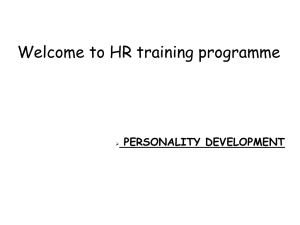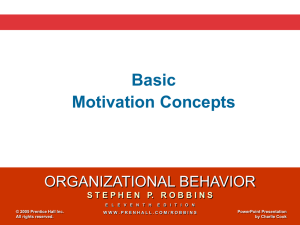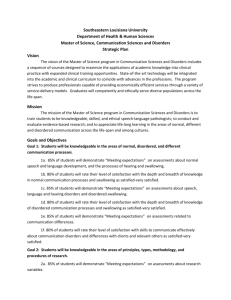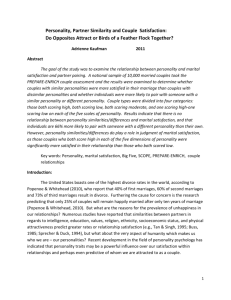File - BBA Group A 2010
advertisement
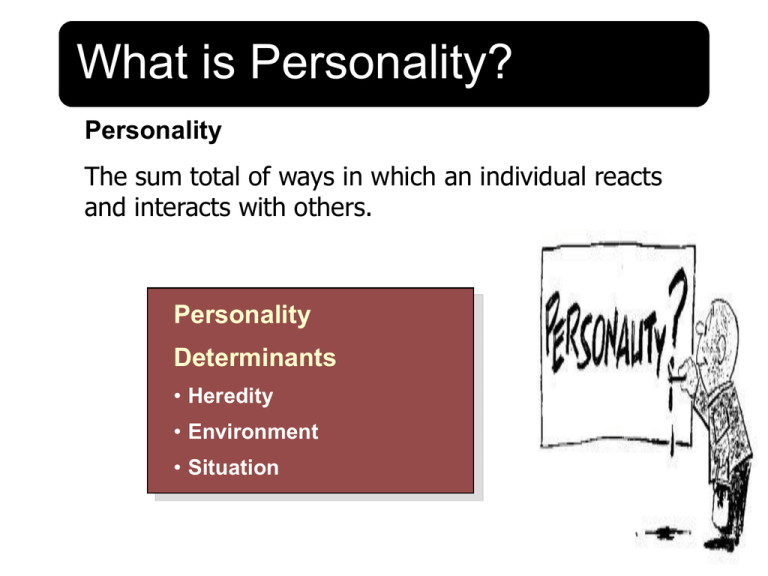
What is Personality? Personality The sum total of ways in which an individual reacts and interacts with others. Personality Determinants • Heredity • Environment • Situation The Myers-Briggs Type Indicator Myers-Briggs Type Indicator (MBTI) A personality test that taps four characteristics and classifies people into 1 of 16 personality types. Personality Types • Extroverted vs. Introverted (E or I) • Sensing vs. Intuitive (S or N) • Thinking vs. Feeling (T or F) • Judging vs. Perceiving (P or J) The 16 types are typically referred to by an abbreviation of four For instance: ESTJ: extraversion (E), sensing (S), thinking (T), judgment (J)--organizers, realistic, logical, analytical INTJ: introversion (I), intuition (N), thinking (T), judging (J)---visionary, original minds, independent, stubborn & determined And so on for all 16 possible type combinations. Other Personality Traits 1) Locus of Control Locus of Control The degree to which people believe they are masters of their own fate. Internals Individuals who believe that they control what happens to them. Externals Individuals who believe that what happens to them is controlled by outside forces such as luck or chance. 2) Self-Esteem and 3) Self-Monitoring Self-Esteem (SE) Individuals’ degree of liking or disliking themselves. Self-Monitoring A personality trait that measures an individuals ability to adjust his or her behavior to external, situational factors. 4) Risk-Taking High Risk-taking Managers – Make quicker decisions – Use less information to make decisions – Operate in smaller and more entrepreneurial organizations Low Risk-taking Managers – Are slower to make decisions – Require more information before making decisions – Exist in larger organizations with stable environments 5) Narcissism Excessive self admiration Worst leaders Less effective 6) High Flyers • • • • Executive potential Future leadership roles Flexible Risking taking ability 4–7 Personality Types Type A’s 1. are always moving, walking, and eating rapidly; 2. feel impatient with the rate at which most events take place; 3. strive to think or do two or more things at once; 4. cannot cope with leisure time; 5. are obsessed with numbers, measuring their success in terms of how many or how much of everything they acquire. Type B’s 1. never suffer from a sense of time urgency with its accompanying impatience; 2. feel no need to display or discuss either their achievements or accomplishments; 3. play for fun and relaxation, rather than to exhibit their superiority at any cost; 4. can relax without guilt. Values Values Individuals idea as to what is right & wrong Value System A hierarchy based on a ranking of an individual’s values in terms of their intensity. Importance of Values understand individuals and cultures. Influence our perception of the world around us. Represent interpretations of “right” and “wrong.” Imply that some behaviors or outcomes are preferred over others. Types of Values Terminal Values Desirable end-states of existence; the goals that a person would like to achieve during his or her lifetime. Instrumental Values Preferable modes of behavior or means of achieving one’s terminal values. Terminal Values include things like happiness, self respect, family security, recognition, freedom, inner harmony, comfortable life, professional excellence, etc Instrumental values: values like honesty, sincerity, ambition, independence, obedience, imaginativeness, courageousness, competitiveness, and also some negative traits too. Instrumental Values are difficult to change. Hofstede’s Framework for Assessing Cultures 1) Power Distance The extent to which a society accepts that power in institutions and organizations is distributed unequally. low distance: relatively equal distribution high distance: extremely unequal distribution 2) Individualism 2) Collectivism The degree to which people prefer to act as individuals rather than a member of groups. A tight social framework in which people expect others in groups of which they are a part to look after them and protect them. 3) Achievement The extent to which societal values are characterized by assertiveness, materialism and competition. 3) Nurturing The extent to which societal values emphasize relationships and concern for others. 4) Uncertainty Avoidance The extent to which a society feels threatened by uncertain and ambiguous situations and tries to avoid them. High ----low 5) Long-term Orientation A national culture attribute that emphasizes the future, thrift, and persistence. 5) Short-term Orientation A national culture attribute that emphasizes the past and present, respect for tradition, and fulfilling social obligations. Attitude Nature & Dimensions of Attitude “Judgment concerning objects, people & events” – – – – – Determinant of behavior Are learned Define our perception of aspects of world Are close to our personality Can be changed Components of Attitude Attitudes Evaluative statements or judgments concerning objects, people, or events. Cognitive component The opinion or belief segment of an attitude. (thought process) Affective Component The emotional or feeling segment of an attitude. Behavioral Component An intention to behave in a certain way toward someone or something. Types of Job Attitudes 1) Job Satisfaction A collection of positive and/or negative feelings that an individual holds toward his or her job. 2) Job Involvement Identifying with the job, actively participating in it, and considering performance important to self-worth. 3) Organizational Commitment Identifying with a particular organization and its goals, and wishing to maintain membership in the organization. 4) Perceived Organizational Support (POS) Degree to which employees feel the organization cares about their well-being. 5) Employee Engagement An individual’s involvement with, satisfaction with, and enthusiasm for the organization. JOB DISSATISFACTION How Employees Can Express Dissatisfaction Exit Voice Behavior directed toward leaving the organization. Active and constructive attempts to improve conditions. Loyalty Neglect Passively waiting for conditions to improve. Allowing conditions to worsen. Responses to Job Dissatisfaction Source: C. Rusbult and D. Lowery, “When Bureaucrats Get the Blues,” Journal of Applied Social Psychology. 15, no. 1, 1985:83. Reprinted with permission. The Effect of Job Satisfaction on Employee Performance Satisfaction and Productivity – Worker productivity is higher in organizations with more satisfied workers. – Satisfied workers aren’t necessarily more productive. Satisfaction and Absenteeism – Satisfied employees have fewer avoidable absences. Satisfaction and Turnover – Satisfied employees are less likely to quit. – Organizations take actions to retain high performers and to weed out lower performers. Satisfaction and Organizational Citizenship Behavior (OCB) – Satisfied employees who feel fairly treated by and are trusting of the organization are more willing to engage in behaviors that go beyond the normal expectations of their job. Satisfied employees increase customer satisfaction because: – They are more friendly, upbeat, and responsive. – They are less likely to turnover which helps build longterm customer relationships. – They are experienced. Dissatisfied customers increase employee job dissatisfaction.


